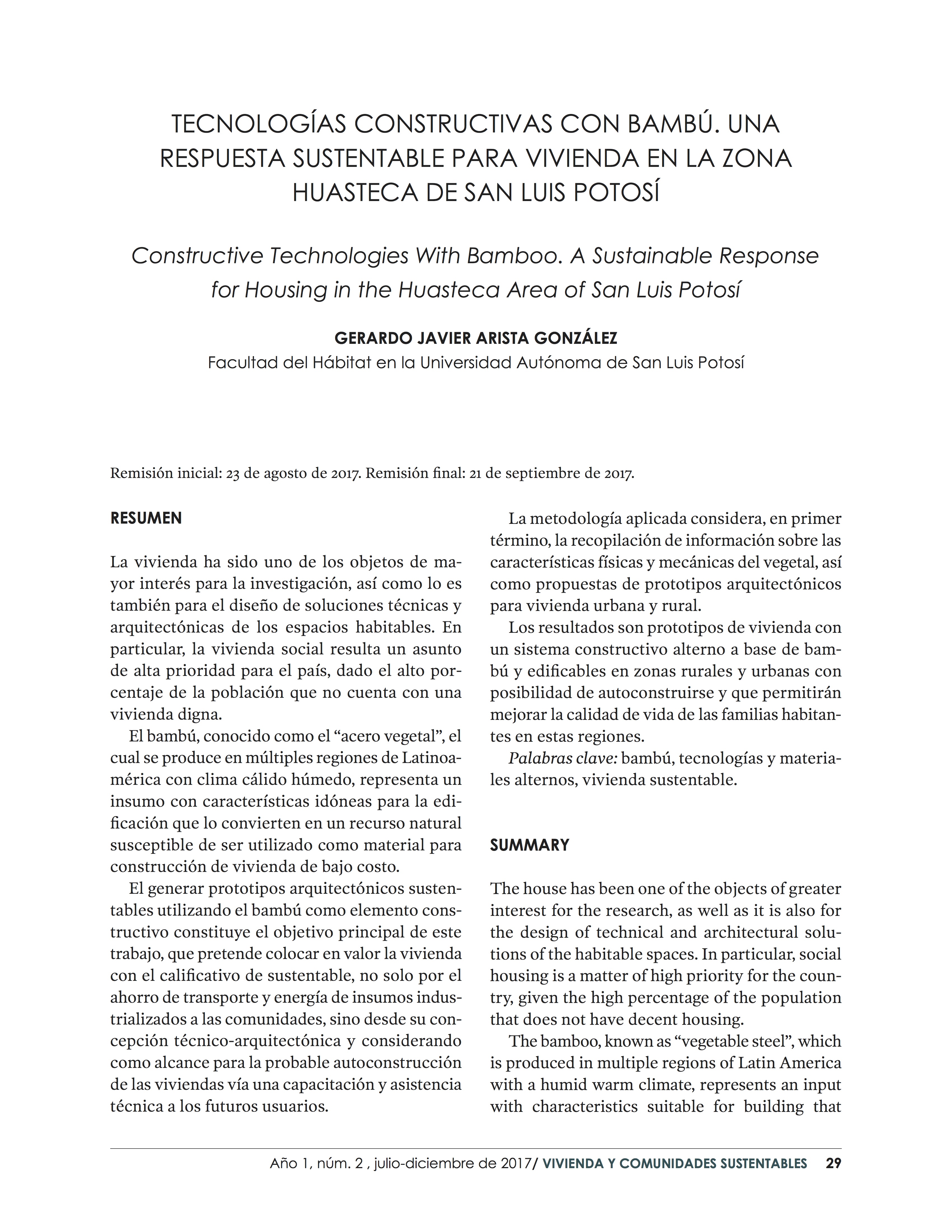Constructive Technologies With Bamboo. A Sustainable Responsefor Housing in the Huasteca Area of San Luis Potosí
DOI:
https://doi.org/10.32870/rvcs.v0i2.27Keywords:
bamboo, technologies and alternative materials, sustainable housingAbstract
The house has been one of the objects of greater interest for the research, as well as it is also for the design of technical and architectural solutions of the habitable spaces. In particular, social housing is a matter of high priority for the country, given the high percentage of the population that does not have decent housing. The bamboo, known as “vegetable steel”, which is produced in multiple regions of Latin America with a warm humid climate, represents an input with characteristics suitable for building that make it a natural resource susceptible to be used as a material for low-cost housing construction. To generate sustainable architectural proto-types using bamboo as a constructive element constitutes the main objective of this paper, which aims to place in value the house with the quali cation of sustainable, not only because of the saving of transport and the energy of industrialized inputs to the communities, but from its technical-architectonic conception and considering how to reach the probable auto-construction of the houses by means of training and technical assistance to future users. The applied methodology considers, firstly, the compilation of information on the physical and mechanical characteristics of the plant, as well as proposals for architectural prototypes for urban and rural housing. The results are prototypes of housing with an alternative constructive system based on bamboo and buildable in rural and urban areas with the possibility of being built and that will improve the quality of life of the families living in these regions.Metrics
References
Brundtland G. H. (1987). "Our Common Future". World Commission on Environment and De- velopment, cit. en García Rodríguez, Salvador et al. (2005). Propuesta de modelo integral de evaluación sostenible de la vivienda social en México. www.seer.ufrgs.br /ambienteconstrui- do /article/view/
EuropeAid (2009). Cambio climático en América Latina. AGRIFOR Consult.
García Rodríguez, Salvador et al. (2005). Propuesta de modelo integral de evaluación sostenible de la vivienda social en México. www.seer.ufrgs.br/ ambienteconstruido /article /view/
Hinojosa, Eduardo (2014). "El manejo de áreas ver- des en la Cd. de México y Pekín: buscando la sustentabilidad en las urbes". Investigación ambiental, ciencia y política pública. SEMARNAT-INECC, vol. 6, núm. 1. http://www. revista. inecc.gob.mx/article/view/218
INEGI http://www.inegi.org.mx/
Jiménez Moreno, Pablo (2013). "Vivienda de interés social en México. Historia y contexto". http:// www.burovarquitectos.com / blog /2015 /un-análisis-sobre-casas-de-interes-social-en-mexico
Martín, Rubén (2013). "Vivienda de 34 metros cuadrados". http://eleconomista.com.mx /antipo- litica/2013/03/30/viviendas-34-metros-cuadrados
Morales, Iván (2009). "La importancia del de- sarrollo sostenible". Economía + Desarrollo. https://economiaydesarrollo.wordpress. com/2009/01/31/desarrollo-sostenible/
Sánchez Corral, Javier (2012). La vivienda social en México, pasado, presente y futuro. México: Sistema Nacional de Creadores de Arte, 2008.
Sociedad Hipotecaria Federal (2012). "¿Por qué autoproducción de vivienda asistida?". http:// www.conorevi.org.mx/pdf/Evento29y30agosto/ AVA.pdf

Downloads
Published
How to Cite
Issue
Section
License
Copyright (c) 2017 Vivienda y Comunidades Sustentables

This work is licensed under a Creative Commons Attribution-NonCommercial-NoDerivatives 4.0 International License.
The authors who publish in this journal accept the following conditions:
In accordance with the copyright legislation, Sustainable Housing and Communities recognizes and respects the moral right of the authors, as well as the ownership of the patrimonial right, which will be transferred to the University of Guadalajara for its dissemination in open access. Sustainable Housing and Communities does not charge authors for submitting and processing articles for publication. Authors may make other independent and additional contractual agreements for the non-exclusive distribution of the version of the article published in Sustainable Housing and Communities (for example, include it in an institutional repository or publish it in a book) as long as they clearly indicate that the work is published for the first time in Sustainable Housing and Communities.





